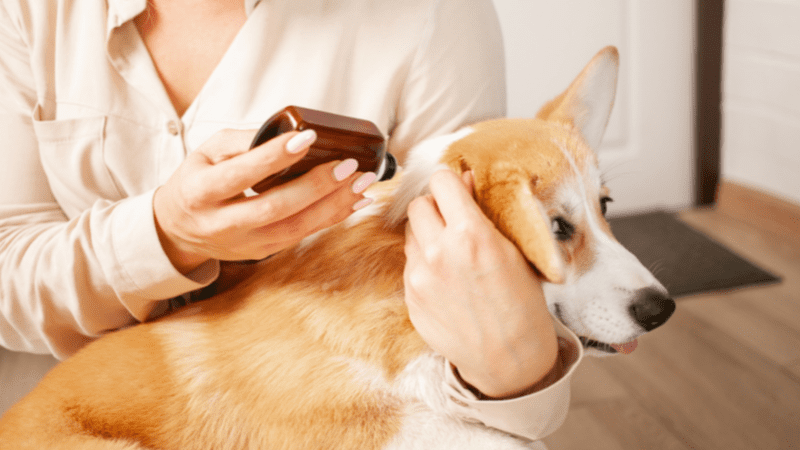Dogs are wonderful animals to have as pets because they bring unlimited energy and wagging tails into our lives. However, even creatures with as much spirit as these may experience their fair share of suffering. Dog Heat Rash is a problem that frequently goes unchecked, which puts our four-legged pals in a situation that can cause them to feel itchy and uncomfortable. In this post, “Dog Heat Rash: Uncovering the Common Causes With Solutions” we’ll go out on an adventure to learn the ins and outs of dog heat rash, as well as the startling causes of it and the surprisingly easy cures to it.
Causes of Dog Heat Rash: A Closer Look
Dog heat rash, also known as Canine Pruritic Eruption, is a disease in which our canine and feline companions suffer from skin irritation as a result of exposure to high temperatures and high levels of humidity. Consider it to be the canine equivalent of the heat rash that affects humans. What is the major factor? very active sweat glands in the body. The only means of cooling that dogs have is by panting, which isn’t always enough. This results in an excessive amount of moisture being trapped on the skin, which is the perfect formula for developing a heat rash.
Comparative Analysis
Let’s look at this topic from a different angle by drawing some comparisons. Dogs perspire largely through their paw pads, in contrast to humans, who have sweat glands dispersed throughout their entire bodies. As a result of this underlying difference, they are more likely to get a heat rash. Their fur, which is a miracle of insulation when temperatures are lower, may become a curse when temperatures are higher because it retains moisture and makes the problem worse.

Graphs and Tables: Visualizing the Impact
The incidence of heat rash in several dog breeds is shown in this graph.
| Dog Breed | Incidence of Heat Rash |
| Pug | High |
| Labrador | Moderate |
| Siberian Husky | Low |
As can be seen in the graph that is shown above, certain breeds, like as Pugs, are more prone to developing heat rash because of the facial creases that they have, but other breeds, such as Siberian Huskies, have a lower incidence of the condition because of the well-adapted double coats that they have.
Simple Solutions: Easing the Itch
Let’s turn our attention to potential answers right now. Prevention is the key, and there are things you can do to ensure that your canine companion does not get a rash.
FAQs
How can I prevent heat rash in my dog?
Make sure there is a enough supply of water, offer spaces that are shaded, and minimize your time spent outside when the temperature is at its highest. Grooming your dog on a regular basis, particularly for breeds with long hair, helps avoid excess accumulation of moisture.
My dog already has heat rash. What action should I take?
Your first step should be to seek the advice of a qualified veterinarian. They could suggest a medicated shampoo or a topical treatment to treat the condition. It may be helpful to your dog’s healing if you keep their environment cold and dry, as well as their skin.
Can I use human products on my dog’s rash?
No, doing so is not a good idea. The pH levels of a dog’s skin are different from those of humans, and using items made for humans might make the problem worse. Stick to remedies that have been recommended by the vet.
Are certain dog breeds more prone to heat rash?
The answer is that some breeds, namely those with folds, wrinkles, or thick coats, are more prone to the condition. Certain breeds, including Bulldogs, Shih Tzus, and Pugs, have a significantly increased risk.
Is heat rash only a summer issue?
Even though it happens more frequently when the weather is hot and humid, it may happen at any time of the year, particularly if your dog is subjected to an abnormally high temperature.
Can diet play a role in preventing heat rash?
Without a doubt. A nutritious diet is important for maintaining good skin as well as general wellness. For example, omega-3 fatty acids are beneficial to the health of the skin.
Can I use over-the-counter creams?
Before using any lotions, it is important to get the advice of a qualified veterinarian. They are able to direct you toward alternatives that are both secure and efficient.
Are there home remedies I can try?
A cold compress can help ease moderate inflammation, but avoiding it altogether is the best course of action. In severe circumstances, though, you should seek the advice of a veterinarian.
In Conclusion: Caring for Your Canine Companion
The fact that we can effectively treat heat rash in our dogs, despite its annoying nature, is evidence that we are responsible pet owners. By gaining an awareness of the factors that contribute to the condition and taking steps to avoid it from occurring in the first place, we can make sure that our faithful friends have lives that are free from the itching and suffering caused by heat rash. Keep in mind that a relaxed and comfortable canine is a happy canine.
Tell us in the comments, how you like our article “Dog Heat Rash: Uncovering the Common Causes With Solutions”
For similar posts like this, click here.
For the source file, click here.




